The Best Employee Training Software in 2026

Workplace training often starts with good intentions. Better skills. Better performance. Better results. Then reality steps in. Different roles. Different pressures. And different ways of learning. A single course rarely works the same way for everyone.
That is where employee training software comes in. Not as a magic fix. But as a way to bring order to something that is naturally messy. Learning does not happen all at once. It occurs in pieces, over time. With practice, mistakes, and reflection in between.
💡 This article helps you choose employee training software and training courses that fit your team for employee development – and not just your budget. All this will ensure the right mobile learning and social learning.
The 11 Best Employee Training Software to Consider
For small businesses, employee training solutions need different considerations. You don’t need a steep learning curve.
You’d ask yourself questions like, does the employee development platform include compliance training? What about the customer support? Does it have a mobile app? Are the training courses and mobile learning suitable for your workforce? We tell you about choices that offer the right training ROI, have the reporting features you need, and is easy on compliance management.
1. iSpring LMS
Workplace learning rarely follows a clean path. People join at different times. Roles evolve. Expectations change. iSpring LMS is built for that reality.
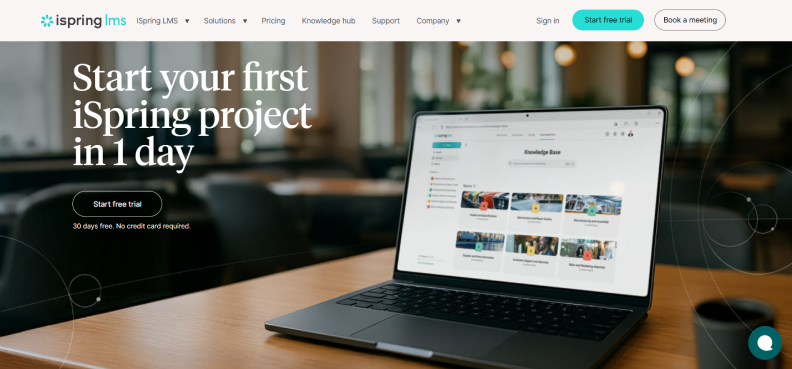
Why we picked it
iSpring supports the full training process, from onboarding and assessment to ongoing development – without forcing teams into rigid workflows. It’s got one of the better user friendly interface you’d see out there.
The platform fits naturally into daily work. User imports are quick. Course enrollment happens automatically. Reports arrive fast and stay easy to read. Learning tracks are simple to build, and training content can be created or updated using the built-in course development tools powered by iSpring AI. Nothing feels bolted on. Small businesses would love it for its flexibility, and it even has its own training app, offering mobile accessibility and interactive content for any user groups you create, ideal for continuous learning.
Pricing
Pricing is transparent. Plans start at $4.46 per user per month, billed annually for 300 users. There are options for small teams and larger groups, also.
Best for
- Teams that need to monitor employee progress across onboarding, compliance, and skills training.
- Organizations managing growing and evolving training programs.
- L&D teams are looking to reduce manual follow-ups and reporting work.
Our hands-on take
We found iSpring LMS prepared out of the box. Pre-built courses from iSpring Academy come loaded, covering sales, compliance, productivity, and more. Integrations with libraries like Udemy, Go 1, and Linkedin learning expand that catalog without extra effort.
Social learning fits naturally alongside structured courses. Support also stands out. A dedicated customer success manager stays involved, helping teams keep learning aligned with real business goals.
2. LearnUpon
Training grows fast. New learners, new courses, and new systems to connect. What often starts simple can become hard to manage. LearnUpon is built to keep that growth steady.
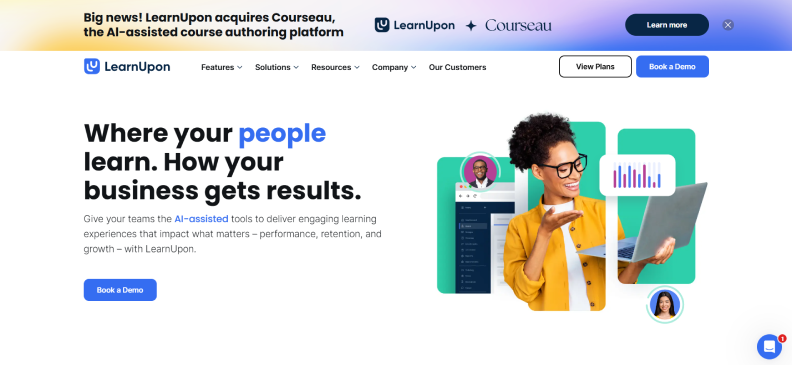
Why we picked it
At its core, LearnUpon focuses on clarity. Course creation is straightforward and can blend in nicely with your employee training program. Training delivery feels controlled, not rushed. Teams can organize users, assign learning, and manage access without jumping between tools. That makes it easier for learners to access materials without confusion.
The platform also supports engagement in quiet ways. Leaner engagement tools encourage participation without forcing it. Features like portals allow different audiences to have tailored spaces, which helps training feel more relevant. Reporting tools add visibility, so progress is not guessed but understood.
LearnUpon also leans into connection. Integrations link training to existing systems. AI-powered learning tools support faster content delivery and smarter experiences over time. Together, these features support collaborative learning without adding complexity.
Pricing
LearnUpon uses custom pricing based on learner numbers and features. There are core plan options like the Essential plan, the Premium plan, or the Enterprise plan. You can choose the one according to your needs.
Best for
Organizations that need a structured training platform with strong delivery and engagement features. Great for customer training and as a mobile app.
Our hands-on take
Using LearnUpon feels calm and dependable. It stays out of the way and lets training happen. Courses are easy to manage and learners always know what comes next. It suits the teams that value clarity over complexity.
3. Docebo
Learning programs often fail before they begin. Not because of content. But because the platform underneath cannot keep up. Docebo is built to be that foundation.
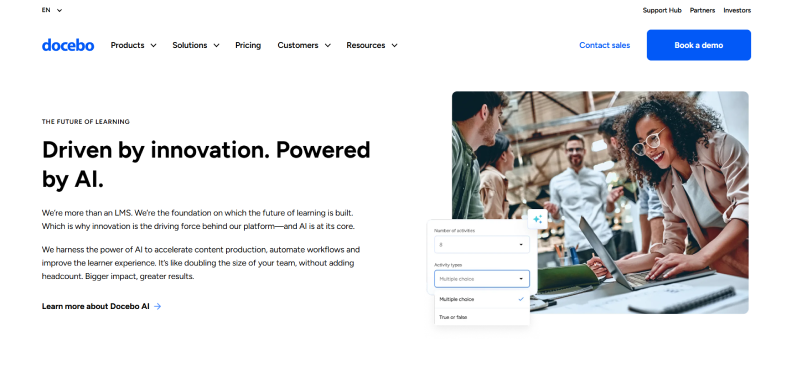
Why we picked it
This supports learning across roles, teams, and audiences. It never forces everything into a single rigid structure. The best part about this platform is that it is AI-centred. The platform uses automation to reduce manual work. Content recommendations, workflow support, and smarter delivery paths. All these features help learning teams focus less on administration and more on outcomes.
Pricing
Docebo does not publish fixed pricing. Costs are tailored based on use case, audience size, and feature needs. This model suits organizations with complex or growing learning programs that need flexibility.
Best for
It works best for mid to large-sized organizations that run multiple learning initiatives at once. Employee onboarding. Compliance training. Sales enablement. Customer and partner education. It is designed for teams that need one platform to support many learning goals.
Our hands-on take
According to us, Docebo, as an external training tool for online training, feels ambitious. It is built for momentum. AI-driven tools help learning move faster without feeling rushed. Programs scale smoothly. Content stays organized. And learning adapts as needs change. It suits teams that want learning to grow alongside the business, not lag behind it.
4. eFront
Training looks different once organizations grow. More learners mean more roles. And that leads to more rules to follow. eFront is built for that stage.
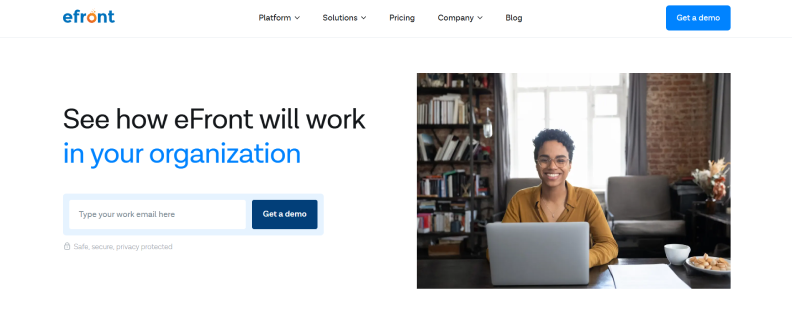
Why we picked it
It is designed to match how large teams actually work, without carrying the weight of outdated systems. What stands out first is flexibility. eFront supports multi-tenancy, so different audiences can train in their own spaces without confusion. Branding tools make training feel like part of the organization, not a separate system. Security is also taken seriously. That includes control suited for regulated environments.
The platform offers interactive courses. It combines media, assessments, and instructor-led sessions. Learning paths can be structured around roles and skills. It contains rules that guide people forward instead of pushing them through repetition.
Pricing
eFront uses a custom pricing model based on the number of users and deployment needs. Plans start at $720 per month for registered users and $1600 per month for active users, billed annually. Enterprise configurations are priced individually.
Best for
eFront is a strong fit for enterprise organizations managing complex training programs. It works well for internal employee development, compliance-heavy industries, and teams that need control across multiple audiences and portals.
Our hands-on take
We found eFront easy and deliberate. It keeps training organized, even when programs grow complex. Progress dashboards make it easy to track employee progress and track progress over time without digging through reports. Automations quietly reduce admin work. And mobile access helps learning stay connected to real work, wherever it happens.
5. Bridge
Training often falls apart when tools feel too complicated. Admins struggle to set things up. Learners lose track of what really matters. Bridge takes a different path. It keeps training simple, clear, and easy to follow.
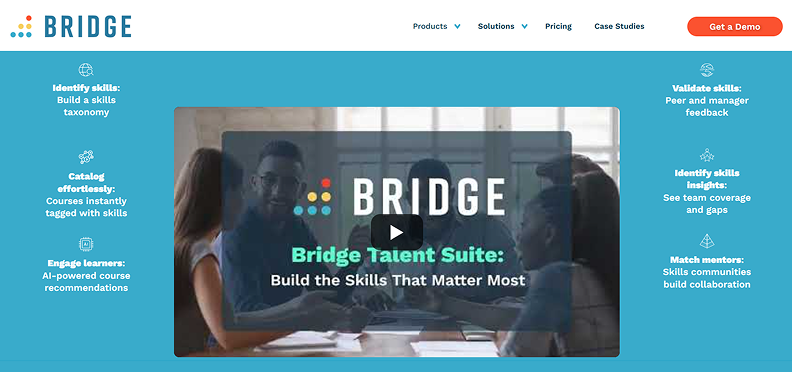
Why we picked it
What stands out for Bridge is the clarity it provides. Courses, assignments, and deadlines are easy to understand. Learners always know what they need to do next. For admins, creating and sharing training does not feel technical or heavy. Content moves quickly from an idea to something people can actually use.
Another great feature is its built-in content options. The platform includes a library of short microlearning lessons for busy schedules. When teams need more, integrations with OpenSesame and Skillsoft open access to thousands of courses. These cover skills, compliance, and professional development.
Training is broken into smaller steps. It can adjust automatically based on roles or location. That takes away the need to master technical skills.
Reporting tools make it easy to monitor employee progress and share updates with stakeholders.
Mobile access supports frontline and deskless workers. That helps learners stay on track without constant connectivity.
Pricing
Pricing is based on the number of users and selected features. Add-ons are also available for content libraries and talent development tools.
Best for
Organizations that want simple training delivery, strong content libraries, and support for distributed teams.
Our hands-on take
According to us, this learning platform is pretty approachable. Nothing gets in the way of learning. Training stays focused, organised, and easy to manage. That makes long-term adaptation feel natural, not forced.
6. Absorb LMS
Training starts to lose impact when platforms cannot grow with the business. Not because teams lack effort. But because the system feels rigid over time. Absorb LMS is built to evolve that. This cloud-based LMS adapts as organizations change, scale, and take on new goals.
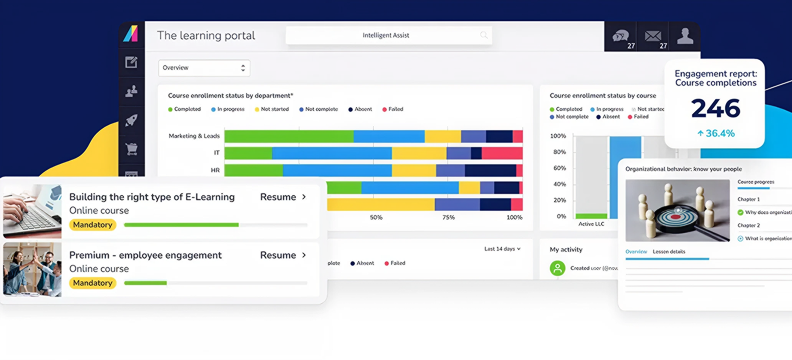
Why we picked it
At its core, Absorb LMS is AI-powered. But you will not find it complicated at all. Managing training stays simple. Courses are easy to deliver. And admins are not buried under manual work making it an online learning training portal worth a try.
The platform supports employee growth, compliance needs, and long-term business priorities from one place.
What stands out is how flexible the ecosystem is. Absorb Infuse brings learning into the tools teams already use, so training shows up at the right moment. Absorb Engage adds social and interactive elements that make learning feel less isolated. Absorb Create helps teams build content faster, without switching platforms. Absorb Analyse turns learning data into clear insights that actually guide decisions.
Strong integrations matter too. Naive connectors for Salesforce and ADP keep data accurate and workflows smooth. Absorb Amplify adds ready-made content libraries to speed up training and upskilling.
Pricing
Absorb LMS uses customized pricing based on an organization’s size, features, and use cases.
Best for
Great for organizations that want an AI-driven platform that supports growth and seamless integrations.
Our hands-on take
We found the platform pretty balanced in all aspects. Powerful when you need depth. Simple when you need speed. Learning grows without becoming hard to manage.
7. TalentLMS
Training often slows down before it even starts. Too many steps, too much setup, and too many decisions. TalentLMS removes that friction early.
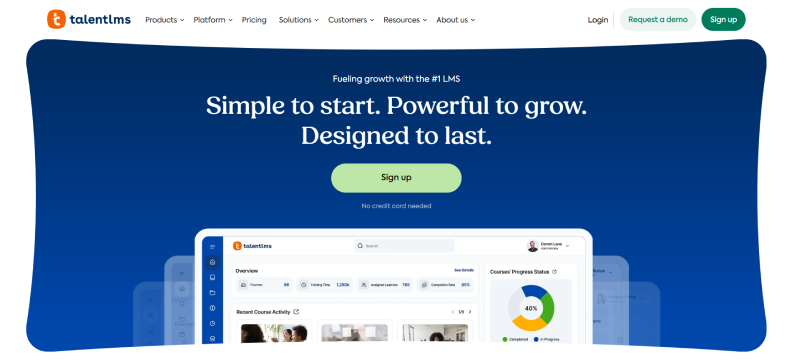
Why we picked it
With TalentLMS, you can launch fast, create courses, upload courses, and customize the portals – just the type of personalized learning paths you’d want for your employees. You can create unlimited courses all without heavy technical work. Content control is another reason this platform stands out. Teams can upload their own materials and use the AI course generator.
There is also an option to pull from a large library of ready-made courses. Skill-based learning adds more clarity. AI helps to map skills, highlights gaps, and connects people to the right learning paths. You can set up mandatory training courses, and evaluate employee performance easily.
User management stays simple. Roles and permissions are clear. Automations quietly handle the routine tasks. That frees up time for an actual learning strategy. Integrations work the same way. HR tools and communication platforms connect without IT involvement. This keeps the data synced and workflows clean.
Learning never feels flat. Blended learning supports online courses and live sessions. Gamification keeps the engagement high with leaderboards, badges, and points. Job Pathfinder adds long-term value. It links learning to career growth, helping employees see where skills can take them.
Pricing
TalentLMS offers flexible plans, including a free tier, with paid plans scaling by users and features.
Best for
It works best for the teams that want fast setup, clear progress tracking, and flexible training delivery.
Our hands-on take
TalentLMS feels light. It is easy to start and easy to grow. Training stays organized without feeling heavy or forced.
8. WhatFix
Training often fails when it lives outside daily work. People attend sessions. They complete courses. Then they return to their tools and forget what to do next. WhatFix solves this problem at the source. It brings learning directly into the flow of work.
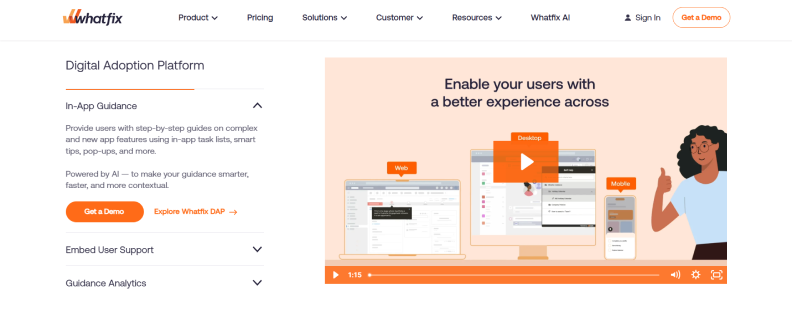
Why we picked it
WhatFix acts as an employee training platform that guides users through the applications they already use. No switching tabs. No searching manuals. Guidance appears exactly when it is needed. The no-code editor makes it easy for teams to create and update in-app guidance without technical help. That keeps training current as tools and workflows change.
AI plays a quiet but powerful role. ScreenSense technology adapts guidance based on user behavior. AI agents help create content and support in-app tasks. This keeps learning responsive instead of static. SCORM compliance adds structure. Training teams can connect WhatFix with an LMS. That builds courses and tracks progress without duplicating effort.
WhatFix works across systems like desktop, mobile, and virtual environments. Even complex workflows that span multiple applications stay connected. This reduces friction and cuts support requests.
Pricing
WhatFix pricing is customized. Costs depend on use case, number of users, and platform coverage. It is typically positioned for mid to large-scale organizations.
Best for
Organizations that want to reduce support tickets, speed up onboarding, and reinforce learning inside the real workflows.
Our hands-on take
WhatFix feels like helpful guidance at the right moment. New users feel less lost. Experienced users stay confident when workflows change. Over time, training blends into daily work and feels natural.
9. Litmos LMS
Employee training only works when people actually use the system. That is where Litmos fits well.
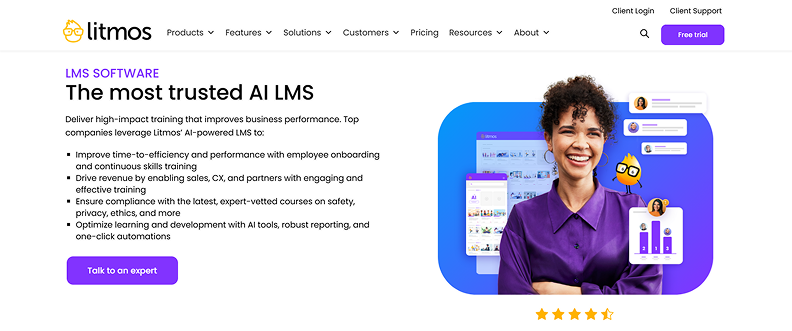
Why we picked it
It is built to remove friction from everyday training tasks. Admins can set up things quickly. Managers can assign training without confusion. And learners can focus on completing courses instead of figuring out how the platform works.
Litmos supports the full employee training process. From onboarding to new hires to building long-term skills across teams. AI authoring makes it easy to create interactive courses. No extra tools. And no complex setup.
Automation handles repetitive work. Group enrollments, learning paths, and alerts. This saves time and keeps the training consistent. Reporting tools make it easy to track employee progress and course completion. So L&D teams can see what is working and what needs improvement.
Social learning features and notifications help keep employees engaged. Learning feels more connected and not isolated.
Pricing
Litmos pricing is customized based on users, features, and content needs. Plans are typically offered through annual subscriptions.
Best for
Organizations that want an easy-to-use employee training software for onboarding and skills development.
Our hands-on take
We found Litmos LMS pretty practical. It does not overcomplicate training. It helps teams stay organised, track progress, and keep learning moving forward without extra effort.
10. Skillsoft
Training often feels scattered when learning lives in too many places. Courses here, videos there. Progress is tracked somewhere else. Skillsoft brings everything together into one learning space that teams can actually use and return to.
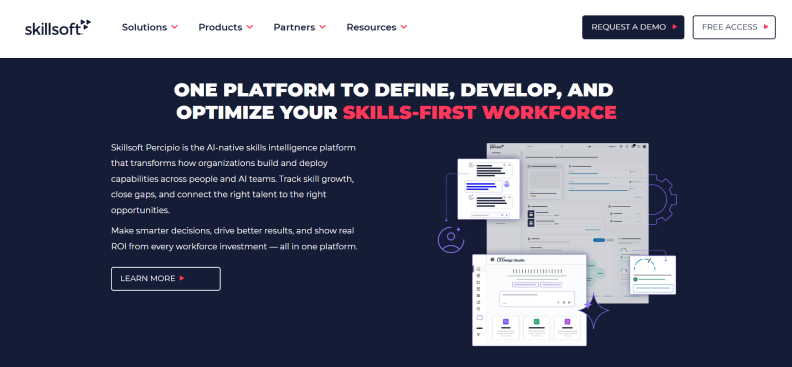
Why we picked it
Skillsoft is built around its Percipio learning platform. It mixes strong content with a learner-friendly experience. Everything feels organized. Not crowded.
The platform offers one of the largest corporate training libraries available. Leadership, business skills, digital tools – all in one place. Content comes in many formats. Short lessons, videos, books, and interactive modules. This helps people learn at their own pace.
Skillsoft also supports structured learning paths. Employees are not left guessing what to do next since AI-powered recommendations suggest relevant content. Curated journeys guide learners toward real goals. Tools like Skills Benchmarks help teams measure real impact and ROI – not just completion rates.
Training works across devices like desktop, phone. This helps learning fit into the day instead of sitting on the side.
Pricing
Individual access starts at $20 USD per month. And the team access starts at $55 per month. And Enterprise depends on the organization’s size, content access, and future needs.
Best for
Large teams and enterprises are focused on long-term skills, compliance, and continuous development.
Our hands-on take
Skillssoft feels broad but manageable. Content stays relevant. Progress is easy to follow. Learning feels practical and tied to real growth. Not just checked boxes.
11. LearnWorlds
Training and knowledge sharing often start with expertise. But they stall when tools limit how that expertise is delivered. LearnWorlds is built for creators and organizations that want full control over how learning looks, feels, and grows.

Why we picked it
LearnWorlds focuses on turning content into real learning experiences. Courses are not just videos and slides. They include interactive activities, assessments, and live sessions. Interactive video tools allow creators to add questions and prompts inside the content – so the attention does not drift.
The platform also supports flexible assessments. Exams and self-checks are easy to build and adjust. An AI Assistant helps speed up course creation while keeping the creator in control. SCORM and HTML5 uploads work smoothly. This makes it easier to reuse existing materials.
Branding is another strong point. LearnWorlds lets organizations build a full white-label academy. Website builder, mobile app builder – and custom templates. Everything looks and feels like your own platform – not a third-party tool.
LearnWorlds also includes built-in marketing and selling tools. Subscription, affiliates, payments – all handled in one place. There is no forever free plan. But the feature depth makes sense for the teams ready to go.
Pricing
Paid plan starts with a low monthly cost of $24 and scales as features increase. Pricing grows with advanced tools like branding and selling options.
Best for
Organizations, educators, and businesses that want branded and interactive learning programs with selling built in.
Our hands-on take
LearnWorlds feels creative and flexible. It gives room to experiment, refine, and build learning that feels intentional rather than generic.
Types of Employee Training Software
Not all training tools are built for the same job. Some focus on structure, others on flexibility. Understanding the differences helps the team choose what they actually need. Not the ones that just look impressive on paper.
1. Learning management systems (LMS)
These systems are often the starting point. They bring training into one place. Courses, records, progress, and certificates – all tracked and organized.
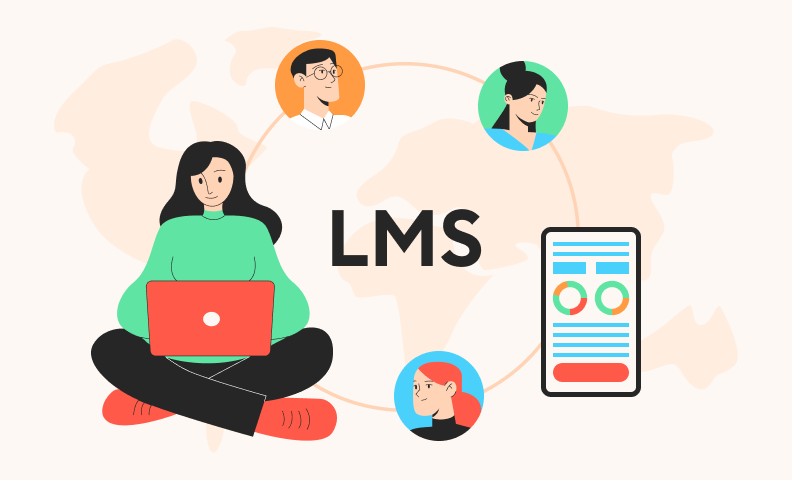
For many organizations, an LMS supports training management at scale. It helps assign learning, track completion, and keep training programs consistent across teams. This is mainly required for onboarding and role-based development.
An LMS can not decide how people learn. But it creates the framework that keeps learning from becoming scattered. According to a recent study, around 83% companies now use an LMS to handle employee training.
2. Learning experience platforms (LXPs)
LXPs take a different approach. They simply focus on exploration instead of guiding learners down a fixed path. Content recommendations. Shared resources. Curated learning journeys. It’s an employee training platform that works a bit differently.

This type of training management works well when learning is ongoing and self-directed. When people want to follow their curiosity or deepen skills at their own pace. LXP often sits alongside more structured systems, adding flexibility rather than replacing control.
3. Microlearning platforms
Some learning needs to be small to be effective. A short reminder. A quick explanation. And a focused example. Microlearning platforms are built for moments like these.

They support learning in short bursts to fit better into busy workdays. They offer clarity one piece at a time instead of overwhelming learners with large courses. This process helps access training materials and improve recall over time. Microlearning does not replace deeper learning. It simply supports it.
4. Virtual classroom software
These are times when learning needs conversation. Questions. Discussion. Shared reflection. Virtual classroom software creates space for real-time interaction – even when people are not in the same room. These are great to deliver training and create training paths.

These tools work well for complex topics and collaborative learning. They allow trainers to respond in the moment and learners to learn from one another.
5. eLearning authoring tools
Authoring tools focus on creation. They help teams access training materials that reflect real work. Real processes. Real challenges.

This matters when generic content falls short. When examples need to feel familiar. When learning needs to reflect on how work actually gets done. Authoring tools give teams control over how learning looks and feels.
On their own, they do not control training programs. But they shape the quality of what learners experience.
How To Choose Employee Training Software
Choosing employee training software is not about finding the most features. It is about making thoughtful trade-offs.
1. Identify your L&D needs
Every training program starts with a reason. Skills gaps. Compliance requirements. Performance issues and growth goals. Without clarity here, tools tend to disappoint.
Start by asking what training is meant to change. What should learners be able to do differently afterward? Clear answers help align with outcomes. Training management works best when purpose comes first.
2. Determine your audience
Not all learners approach training the same way. New hires, frontline staff, managers – each group brings different expectations and constraints.
Some need guidance while others need flexibility. Some have time at a desk. Others learn between tasks. Understanding the audience shapes everything from content format to delivery method.
Good employee training management software adapts to people, not the other way around.
3. Estimate your budget
Budget decisions go beyond license costs. Time matters too. Set up, maintenance, content updates, and reporting. The effort required to manage training programs added up quickly.
Sometimes, a simpler tool that teams actually use delivers more value than a complex system that requires constant attention. Cost-effectiveness often shows up in daily use, not feature lists.
4. Explore the options
Once the needs, audience, and budget are clear, exploration becomes easier. Compare tools based on fit. Look at how they support training programs over time. How they organize training materials. And how they reduce manual work. You’d need options like custom reports, evaluating learning progress, and have access to advanced reporting.
The best employee training software does not demand constant effort. It supports learning quietly in the background. That ultimately helps people to focus on growth rather than administration.
What To Look For When Choosing Employee Training Software
When people start looking for training software, they often jump straight to features. Reports. Dashboards. Automations. And that is quite normal. But those things only matter if the tool fits how your people actually learn and work.
- A system that feels simple: A learning management system should make training easier, not heavier. If it takes too many clicks to assign or find learning, teams will avoid using it. Simple structure matters more than fancy options.
- Progress tracking that tells a real story: Progress tracking should help you see more than who finished a course. It should show where employees slow down, revisit lessons, or drop off. That is how you understand what is helping and what’s not.
- A clear link to employee skills: Training only works when it improves employee skills that matter on the job. Look for tools that support practical learning, not just long content libraries that people forget the next day.
- Fits into daily work, not around it: Good training software works quietly in the background. Employees should not feel pulled away from their job just to “do training.” When learning fits into real work, adaptation happens naturally.
When these basics are right, everything else becomes easier to manage.
FAQs on Online Employee Training Software
Is employee training software the same as a learning management system?
Not exactly. An LMS is usually the core tool used to deliver courses and track learning. Employee training software is a wider category. It often includes an LMS, plus tools for content creation, skills tracking, and reporting. Think of the LMS as the base and training software as the full setup around it.
What is the difference between users and active users when it comes to pricing models?
A user is anyone added to the platform. An active user is someone who actually logs in or completes training during a billing period. Some tools charge for all users, while others charge only for active users. This difference can affect the cost more than expected.
Which is the best software for training?
iSpring LMS is a strong starting point for teams that want training to feel simple and organized. Everything lives in one place so nothing feels scattered or hard to manage. Tracking is clear, and reports are easy to understand. You can see progress without digging through data.
More importantly, you do not need a big team of experts to use it well. It is definitely a smart place to begin if you want employee training that just works from day one. Book a free consultation today to see how it can fit into your team’s training goals.



